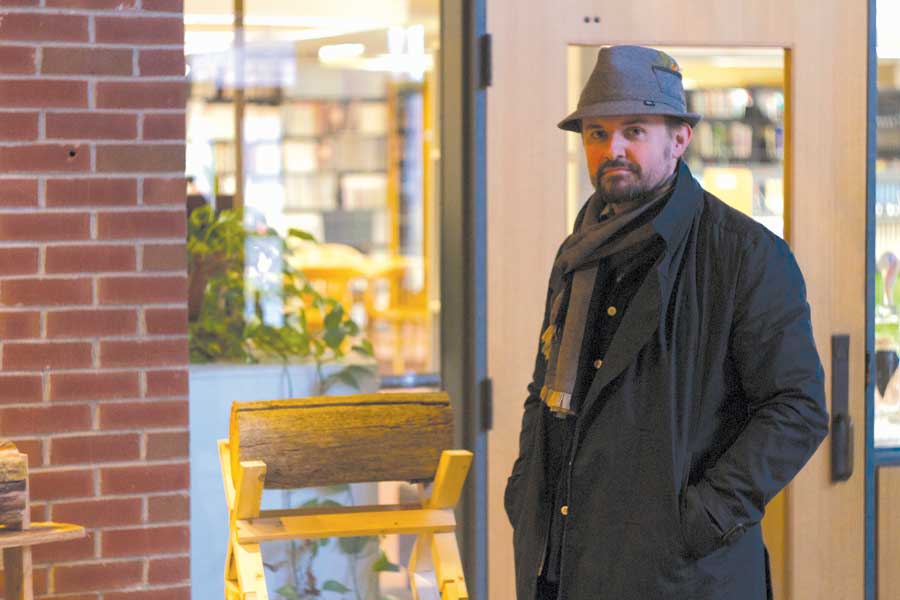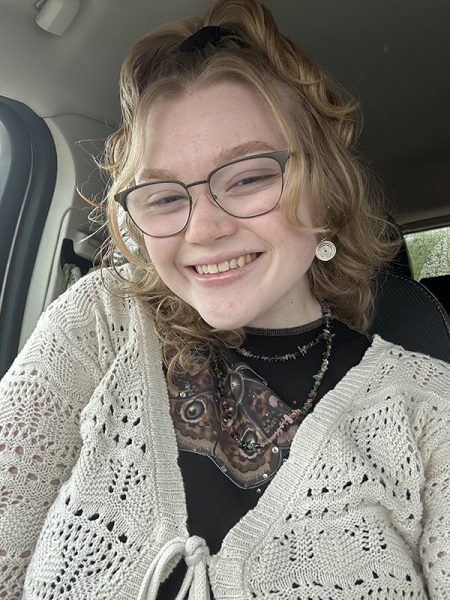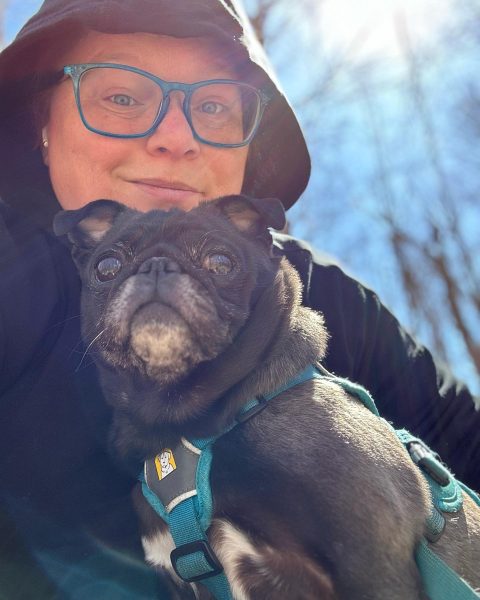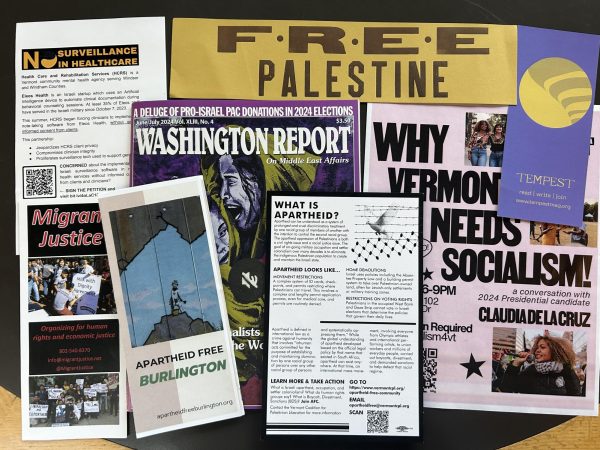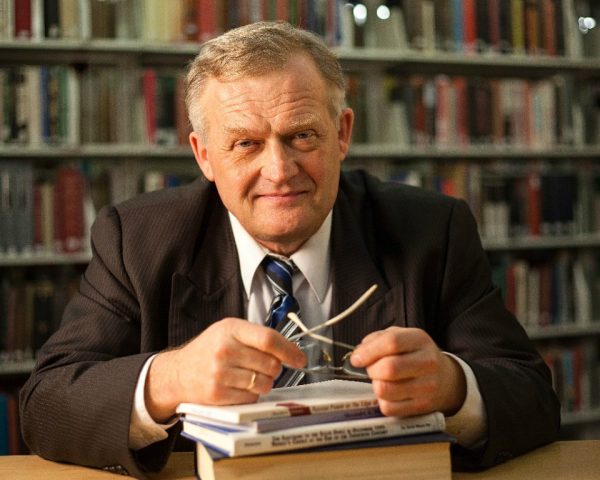“Process.” Zebrowski on architecture, art, and LOG-ing
Michael Zebrowski
Michael Zebrowski is an assistant professor at JSC who uses his background in architecture to help teach sculpture. Zebrowski’s intro to sculpture class recently presented their projects outside of the library on campus. The project, entitled LOG, encouraged students to respond to an object by using limited materials in an effort to help expand their ideas of space and structure. The logs used in this particular project were all taken from a single fallen pine tree that was found on campus.
Q: What was the overall goal of the project?
A: The overall goal was to start getting students to realize what scale is. So one of the things they did was that they had to deal with weight of this log, held at a certain height, and begin to build a structure at that scale. They began with drawings and smaller models that ultimately translated into a full scale construction so jointery and general structural stability was an issue and you can see with some of the ones that are starting to fail if not ones that have already failed structurally. So that was a big part in terms of making and working with wood and also conceptually thinking of sculpture not necessarily as an object in itself but as an object that is based on something else and preceded by another object or another idea. In this case they were given the log itself and then had to respond to it by creating something that would hold it both physically and kind of conceptually. I think those were the two primary goals of the assignment.
Q: Did you come up with the idea for this project?
A: Yeah, this is the second time I have done this project. I did it with a black locust tree in Geneva, NY with students and now we’ve done a pine tree in VT, so it’s been an ongoing kind of serial thing that I’ll probably end up continuing every once in a while, here as well.
Q: Were there certain materials used to hold the log up with?
A: Yes, one of the fundamental lessons was the economy of means and the economy of material. They each got two 2x4x8s so they were limited to using that amount of material. Some used less but most of them found a way to utilize that. The material is inexpensive, not necessarily the best for woodworking, but it was a good material for them to test out some ideas both structurally and conceptually.
Q: Did the students use a program to draw their projects on?
A: Nope they just had hand drawings and we had, as part of the beginning process of working with wood, we had ripped the 2×4 into really small dimensional pieces so they made models that were about 6 inches tall to represent the larger model itself. Over the beginning process of the project they probably made four or five different models to represent their ideas before they went into full scale. The modeling was probably more important than the drawing aspect of that but the drawing being integral to that process all along.
Q: Is the goal of your sculpture class to have a project that can be presented in the end?
A: Yeah definitely, I had sort of surprised my students with this. We have our photography studio lighting set up adjacent to the MARS lab and I had planned it through Leila [Bandar] and the folks at the library to have the exhibit. So we brought them over to photograph and then set them up. They were excited to have that happen and to share the work and to get some feed back. It’s important to the work. We make it in this sort of incubated space but I think part of making any kind of artwork is wanting to share it and get feedback.
Q: What is the relation between architecture and sculpture creation?
A: The material and the process of working with materials is a fundamental connection between the two. Sculpture and architecture in a lot of ways has become, over the last century, a little bit more of a material but I still think that is a fundamental connection between the two. The other is spatial and I think that it’s both a physical thing where you walk around the work and engage it but it’s also a social thing. In this case the work is sort of sharing space and engaging the public in a way that I think can change the dynamic of a space. Even the way that it is set up now, kind of like a serpent that moves through the space so people weave in and through them. In that way this work engages the social aspect of space as well as a physical one.
Q: Why did you choose to be an art teacher instead of an architect?
A: My interests vary on, even in architecture school, an interest not only in making architecture and making a building but really looking more at the fundamental things that make architecture. So when I look at space I talk about it as a physical thing but also as a social enterprise as well, making something that has an effect on people. I always found my work tilting more towards an art practice rather than an architecture practice, which would allow me to engage what I thought of as these fundamentals in a more direct way than when making architecture. My work had always been finding its way into galleries and into the public more as a way of public art than as architecture so it was a natural shift for me in my own practice to shift from an architecture with interest in education into an art practice as an educator in visual art.
Q: Did you always want to be an artist growing up?
A: I always wanted to make things. My grandmother always thought I was going to be an engineer because I always like to make things. I think it was a balance between engineering, architecture, and art that has always been an interest of mine.
Q: Has a single book that you’ve read ever changed your life?
A: There is a book that comes to mind right away and that’s a book called “Flesh.” It’s by Diller and Scofidio and they are a husband and wife who are architects. It’s funny because I was just talking to a graduate student in our MFA program and I said, “This book changed my life.” They are this really incredible sort of marriage of architects that look at these sort of fundamental things in our environment and are exploring them simultaneously through an art and architecture practice. Seeing that book, I think I was a sophomore in design school when that book was presented to me; I got really excited about the things that were in it. There are probably about twenty other books on that list, but that one I think is funny because I was just talking to a student about it.
Q: If you could go back in time where and when would you go?
A: I think in terms of art I would be very interested in going back into the sixties and seventies. I think there were some really great artists that were beginning to push on that line between art and architecture. A lot of them fell into a category of art that was called earth art. They were starting to engage things that were bigger than the canvas and bigger than the gallery. That would be an interesting time to work and to know those people making that work. Then prior to that I would really love to go into the sixteenth century and see how some of these really important pieces of architecture were being made at that point. I would like to see the stonemason and the scaffolding and all the things that really created all of these incredible works of architecture. So you know, I think these two are dramatically different but would be fantastic to see first hand.
Q: Where would you most like to be right now?
A: I like where I am. I do, I like where I am. I think to want to be somewhere else is at times to be distracted from where you are. I really do like where I am and I like where I’m focusing and how I can be a part of this place and how I can grow from being here.
Q: Do you have an earliest memory?
A: It’s hard to say. I’m trying to go back as far as I can. We are affected so much now by photography. Everybody has so many photographs they have seen of themselves as little kids and I think my memories are often tied to those maybe more so than the actual experience. I remember as a kid, very young, splashing around in puddles, I do. It’s one of those things that always really stuck with me, and maybe it is a kind of experiential thing that I kind of look for in my own work that is spatial and social. I remember being with my cousins and those sorts of things but I would highlight that. I can remember a photograph of that but I also remember actually splashing in puddles as well.
Q: What is your greatest fear?
A: I guess to fear too much… to fear too much, and to worry too much. I try to tell myself and my students that a worry and a fear might stop you from doing something, or make you hesitate too much, [so] that you won’t either create something or make mistakes that might be really rewarding.
Q: Do you have a favorite word?
A: “Process.”
Q: What is your greatest wish?
A: For my family to be happy and healthy at all times.
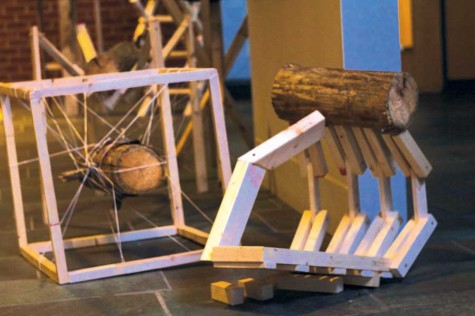
Max Van Wie joined the Basement Medicine staff in Spring 2014, assuming the position of staff reporter.


